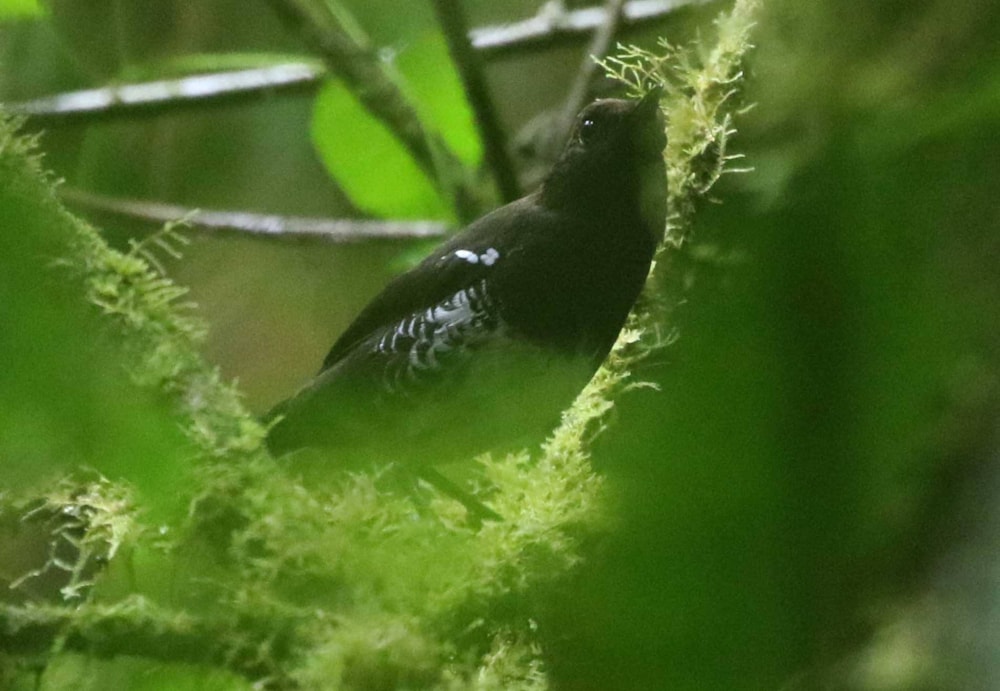What seems like just a few days ago I received a text informing me to check a BirdForum post about a Seram Masked Owl that had been seen in its roosting hole on 6 November. Luckily I had a flight booked to Jakarta on 12th, where I had arranged to meet up with John Gregory (JG). We were planning to visit Enganno and Mentawi, off the southern coast of Sumatra, and then we were off to Lore Lindu, to look for the recently sighted Sulawesi Woodcock. This was a late change to our original plans as we were originally planning on going to Aceh in northern Sumatra with the hope of seeing my last mainland Sumatran endemics, Aceh Bulbul and Roll's Partridge, which I had dipped on a previous trip.
Within a few hours of reading the post another plan was forming in my head – a roosting Seram Masked Owl was just too good to miss. Indonesian masked owls are notoriously difficult to find. I had previous with Minahassa Masked Owl – it had taken me three attempts to see it, as it was never in its roosting hole, but finally saw one at night with JG a couple of years ago. I just had to convince him that it was an excellent idea to go for the owl and then Seram Thrush would be another little 'side trip' – little did we know what that would involve!
I quickly made the necessary arrangements and contacted the local guide in Ambon, Vinno Soewarlan, who was organising the local logistics. Before I knew it I was in Ambon airport, searching for JG, who had expressed his doubt at my bonkers idea. He had read Ross Gallardy's report on his hike to Mount Biniaya for Seram Thrush – it took him six days and was over 70 km, complete with mud and river crossings. As JG stated: "this is not the sort of thing a bloke in his 60th year should be doing – especially with a bloke who has only one kidney!" Nevertheless he was persuaded (/duped) into the plan and was soon enthusiastic about it all. What could possibly go wrong ...
Given we were on Ambon anyway, it seemed rude not to go and see Ambon White-eye, the only island endemic there before we boarded the fast boat to Seram (there is no airport in Seram). After watching a delightful pair of Whiskered Terns, we were soon zooming our way across the water.

Seram is a mountainous, heavily forested and beautiful island, hosting an array of rare and endemic birds (Ashley Banwell).
Once we arrived in Seram it was a lively four-hour drive to our accommodation, where we had a chance to catch our breath before we set out to find the owl. Vinno thought he knew where the roosting tree was and we thought we might as well give it a go, but it was already dark by the time we reached the area and we needed Butji, the local guide, to direct us to the exact tree. While we did hear the owl call tantalisingly close by, we never saw it. Time was pressing and we needed to hunt down Butji, who had gone to a wedding in the next village. Luckily we found him and, miraculously, he was sober!
Another day, another dollar as they say. The next morning he took us to the roosting tree and … nothing there! Disaster … we had dipped! What to do? We needed to crack on with our hike to Mount Biniaya, so we left rather despondent. At least we knew it was around and I was actually confident we could find it the ‘traditional’ way, although I probably didn’t show my confidence at the time.
So, Seram Thrush. The first specimen was collected in 1921 but it took another 78 years before the next sighting of this elusive species in 1989. A further bird was then caught in 2012 and, last year, Ross Gallardy saw it and took the first field photographs. Ross had given me the GPS co-ordinates and a sound recording of a single call. All we had to do was get there.
We arrived at Huaulu, which is the village at the start of the hike, with the aim of getting to Roho, a trek of 7 km, as quickly as possible. The start of the trek is pretty easy going, being mostly along the side of the river and occasionally crossing it, but all below welly-filling depth.
By early afternoon we reached a big, fast-flowing river which we needed to cross and it was here JG had his second dip of the day, quickly followed by a third – he was in the river on all fours! I tried to make light of his situation as I was not convinced he was in a great frame of mind. Although I have known him since 1985, our friendship was going to be tested now – the poor chap is recently retired and was expecting to be drinking Bintang on Enganno after a day of easy birding. Instead here he was, grovelling around on all fours in a river on Seram looking like Mike Tyson searching for his gum shield after Buster Douglas had knocked it out. Oh dear. I hoped we would see the bird and make the trip worthwhile – and save our friendship to boot.

Crossing one of the many fast-flowing rivers and streams along the route (Ashley Banwell).
We finally crossed the river and took a quick coffee break and all was well. Then it started to rain and we were soon drenched to the skin. From here on in, our clothes remained wet for the rest of the week, with variations in levels of wetness ranging from slightly damp to having to wring my socks out. We gritted our teeth and got on with it.
We had to reach Wasimati that day if we were to maintain our gruelling schedule and we made it, just before dusk. Home that night was a single wooden hut seemingly in the middle of nowhere, but it offered us a roof over our heads and a chance to get out of our wet clothes. We had completed 17 km that day and estimated that we were about halfway there.
It had been a tough hike, but we had managed to see a some good birds along the way: a few Long-crested Mynas perched out in the rain on a dead tree, Red Lorys seemed common and we had several Seram Imperial Pigeons. After photographing the resident spiders and a few coffees followed by a rice, noodle and canned fish supper, I was ready for bed, my first chance to get my head down since I left Norfolk three days previously. I slept well!
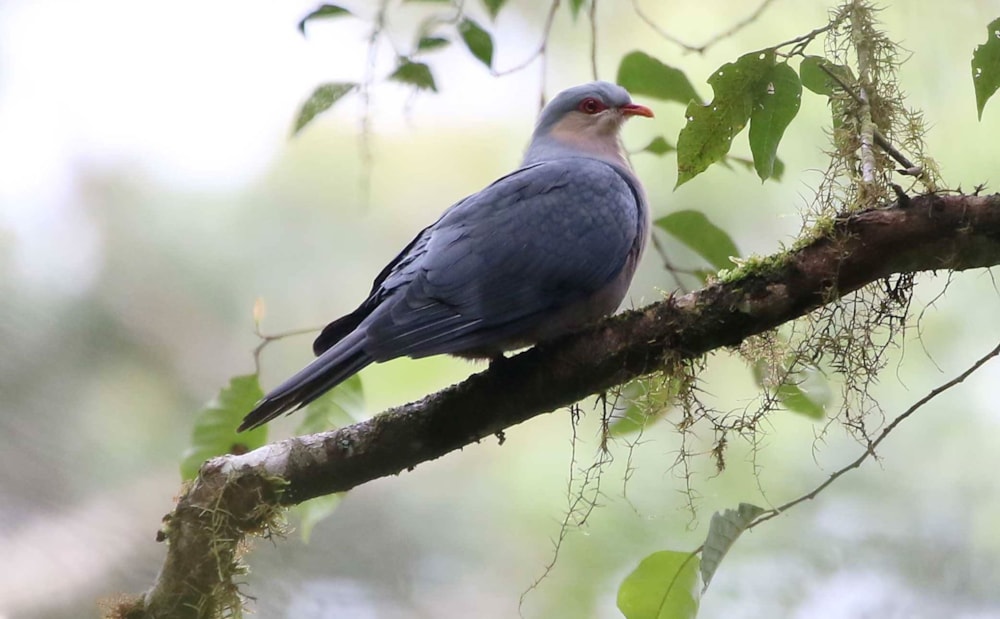
Endemics such as Seram Mountain Pigeon kept Ashley and John going during the often-hellish hike (Ashley Banwell).
You can't beat waking up in the rain forest. I love the anticipation of waiting for the birds to wake up and start calling, it’s magical. Overnight I had woken to the call of Moluccan Scops Owl and Pacific Koel – they seem never to sleep – and the air was filled with birdsong. As dawn broke, Blyth's Hornbills were soon whooshing overhead and we enjoyed their antics as we ate breakfast. Several coffees later, we were off again – first up was a big river crossing, which produced wet feet almost immediately. A Grey Wagtail was hopping over the rocks there – it’s always nice to see familiar birds in odd places.
The day promised a big hike: we had to be at the campsite up the mountain, somewhere near the GPS point we were aiming for by nightfall, which meant another day of close to 20 km walking. We eventually reached the village of Kanikeh, which is a larger village accessed by a rickety bamboo bridge. I crossed it fine, but was not allowed to on the way back as it was considered too dangerous for me – I could not see how it was any more dangerous than before but maybe stupidity and bravery are more easily mistaken for one another than we think.

The rickety bamboo bridge at Kanikeh (Ashley Banwell).
After resting in Kanikeh we had to press on to reach at least 'camp 1'. It was a challenging walk and two of our porters bailed here – bruised, battered, exhausted and overwhelmed at it all, they waited here for us to return. We left a few non-essentials with them to lighten our bags and off we went.
The trail was now very steep and muddy, making for a difficult walk. After a few hours of plodding in the heavy rain, we finally reached camp 1, where we stopped for the night, in our tiny two-man tent. We hung our wet clothes out on the tent guy ropes – fat chance of them drying, but it seemed like the right thing to do. The rain continued for most of the night so at least my clothes got a bit of a rinse!

Camping on the trek up to the thrush site (Ashley Banwell).
Soon it was time to get up. The stars were still out and the sky was stunningly clear, promising a beautiful morning – all we had to do today was to walk a few kilometres to 'camp 2' and see Seram Thrush – it sounded so easy! A Large-tailed Nightjar had been 'chonking' just before sunrise. The signs were good – today was the day.
After breakfast of coffee, rice and noodles, washed down with more coffee, we set off. By about 9 am, we had reached the GPS point, meaning we were in 'thrush zone'. We spent a while around the gully were Ross had seen his thrush but nothing seemed to be calling, so I pressed onwards and upwards. I was restless. I am not one for sitting about and despite knowing better, I continued searching rather than waiting and headed further up the slopes. After 30 minutes I reached a lovely mossy area with loads of bamboo where I sat for a while, under a huge tree while a rain shower passed. I may even have enjoyed a power nap. During my break I watched a nice male Yellow-throated Whistler and a couple of Drab Whistlers – with birds around, there was hope.
After the rain eased, I saw several Seram Leaf Warblers and photographed some Blue-eared Lories. Mountain Tailorbirds were abundant and constantly calling, Little Pied and Snowy-browed Flycatchers were also seen.
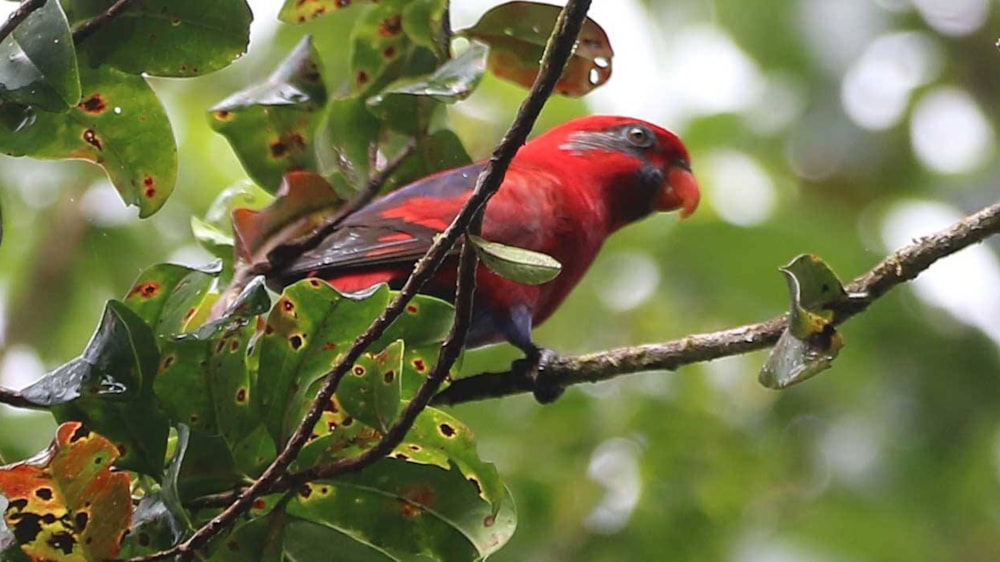
Blue-eared Lory is an attractive parrot endemic to Seram (Ashley Banwell).
Then I heard it. A long, high-pitched whistle. Not much of a call as it goes, but that was it; not dissimilar to a Redwing or even a fruiteater from South America. The thrush had called! I spent the next hour or so in this area; the thrush called very infrequently and I never got close to it. I could tell it was going to be a battle of wits.
I did see a few Seram Grasshopper Warblers in the bamboo – they were surprisingly easy to see, flicking around with their tails cocked, while I also saw my first Grey-hooded White-eye. Overhead the sky was a deep grey and the thunder was rumbling, I knew my time was up for the day so I headed down to where JG was lurking. He had gripped me off with a Seram Pitta, something I never did see, but at least we had a starting point on the thrush – tomorrow was going to be the day. We had to retire early as the rain had set in for the rest of the day; we rested up, drank coffee and thought of a plan. Sitting around was a challenge for me.
Nervous excitement and anticipation had me up and about way before sunrise. I knew today was the day we had to see the thrush. Imagine the thought of dipping, going back and telling everyone you failed. I have had this problem with Moustached Kingfisher before and I was determined not to give up. I was not going home empty handed. We had to see it. Dipping simply was not an option. After all, it's only a thrush – how hard could it be? JG, in his moments of delirium and pessimism wondered if could they be altitudinal migrants. I replied with "nonsense", hoping I was right!
After breakfast we went back to the gully and waited. It was pitch black. Large-tailed Nightjars were still chonking, koels were still calling too, but soon the diurnal birds were vocal – Moluccan Cuckoo, Mountain Tailorbirds, whistlers … and then the thrush called. Game on, we were in business. 'Patience is power' is a Buddhist saying, but it is difficult not to move and resist using payback. I made my own recordings, but the thrush's call is so weak that it was relegated to background noise, difficult to pick out among the other birdsong.
Eventually we walked into the gully and played the tape. The thrush responded! It flew towards us, a black blur … hmm, that was not a good view. We soon abandoned that approach, although we did get a few glimpses as a pair crossed the trail. I decided to head up to where I had heard one yesterday: "maybe it is more active in the morning", I optimistically thought. I'm always over optimistic.
I flushed a thrush out of a bamboo patch and it uttered an alarm call that sounded very similar to our Blackbird – not what I was expecting. Then a female Island Thrush hopped out, a good bird and a seldom-seen subspecies, but not 'the one'. There was not a sniff of yesterday's calling Seram Thrush. Then I heard a shout: it was Dadji, our guide and thrush expert, who had seen it before with RG. I headed back down to the gully where JG had seen one perch up for a few seconds and had enjoyed good views. The old Aboriginal saying, which I often quote, came back to haunt me: 'never turn your back on a roasting turtle' … had I messed up?
I waited patiently at the said spot and the something jumped up and there it was: Seram Thrush! I knew my camera lens was fogged up but rattled off a load of shots anyway. The autofocus was not working due to the misting, but the thrush sat still while I frantically fiddled with the settings. I finally managed some sort of photo, had another view of in through my bins before it hopped off. It had surrendered, we had persevered and been rewarded with great views. Luckily the photos also turned out better than expected. High fives and whoops rang out through the forest. We had done it, we could hold our heads up high – what a difference a minute makes!
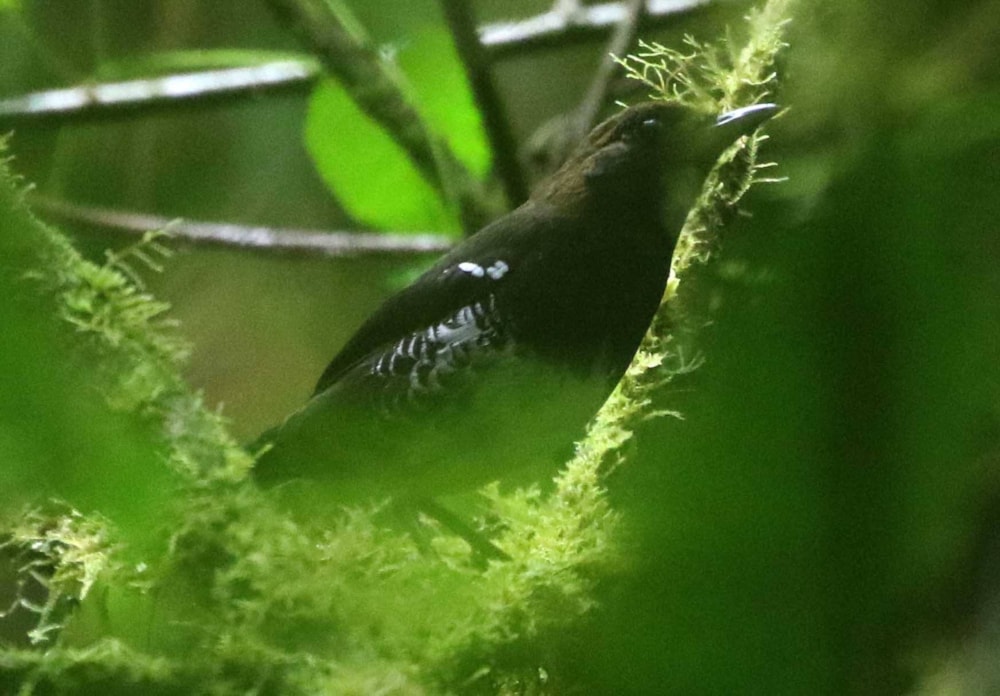
Seram Thrush (Ashley Banwell).
But then the first thing I thought of was Seram Pitta. I had to see that before we left, so I went to the spot where JG saw it the previous day but it really was a half-hearted attempt. The afterglow was burning bright, a male Island Thrush with its grey head attracted my attention and I played the pitta tape, but no response. Was I bothered? Yes and no, but I had reached my Tufted Puffin in Kent moment and thought "it's all downhill from now, is there a harder bird to see?" Moustached Kingfisher will always haunt me, but Seram Thrush was on! Happy days.
Now it was time for coffee and then we had to think about our return. We still had the matter of Seram Masked Owl to deal with, it wasn't over yet and we had the best part of 40 km to walk back.
We made our way back to the camp and packed our stuff together, the first target destination was Kanikeh – it seemed to take an age to get there, I had found myself resting more than usual. We had reached secondary growth but Kanikeh never seemed to appear, surely we were nearly there? I took another stop and, after my five-minute break, I walked 100 metres, only to see the concrete water tank at the start of the village. Finally, we were there and I could have a coffee and get my wellies off. JG soon turned up, knackered. We decided to rest up and blast the rest of the 30-km trek the following day.

Exhausted but elated: Ashley and John after scoring Seram Thrush.
We completed the 30 km the next morning, reaching our guesthouse by 3 pm. Time to have a wash, change clothes and footwear and discuss whether to burst our foot blisters or not. We were tired and sore, but the truth was, the job was only half done – I had come here to see the masked owl too!
The following morning saw us on the trail of the owl and checking the hole once again. It wasn't there! Had we really dipped? A second hole was checked, but a Blyth's Hornbill was living there. I spent the rest of the being very restless and itching to get out again. I suggested to JG that we go back to the hole just before dusk. I had all my gear ready for an all-night owling session, I was determined not to let this one get away – it would be embarrassing. As I made my way back down the owl trail, I looked at the tree early and at a little distance. There was clearly something in the entrance – was it home? Was it a mammal? All I could see was brown-and-white colouration.
I hurried down to the best viewing spot and, yes, it was there! But where was JG? I uttered a few expletives in his direction and shortly after he appeared. We had scored! We spent the next 45 minutes photographing and watching it. I wanted to get some recordings, but Tyto owls call so infrequently that I decided to leave my microphone recording there overnight, pointing towards the tree. It worked very well and I managed six good recordings from the 10 hours of recordings, also picking up Moluccan Scops Owl, Hantu Boobook and Pacific Koel. And with that, an extraordinary journey came to an end.
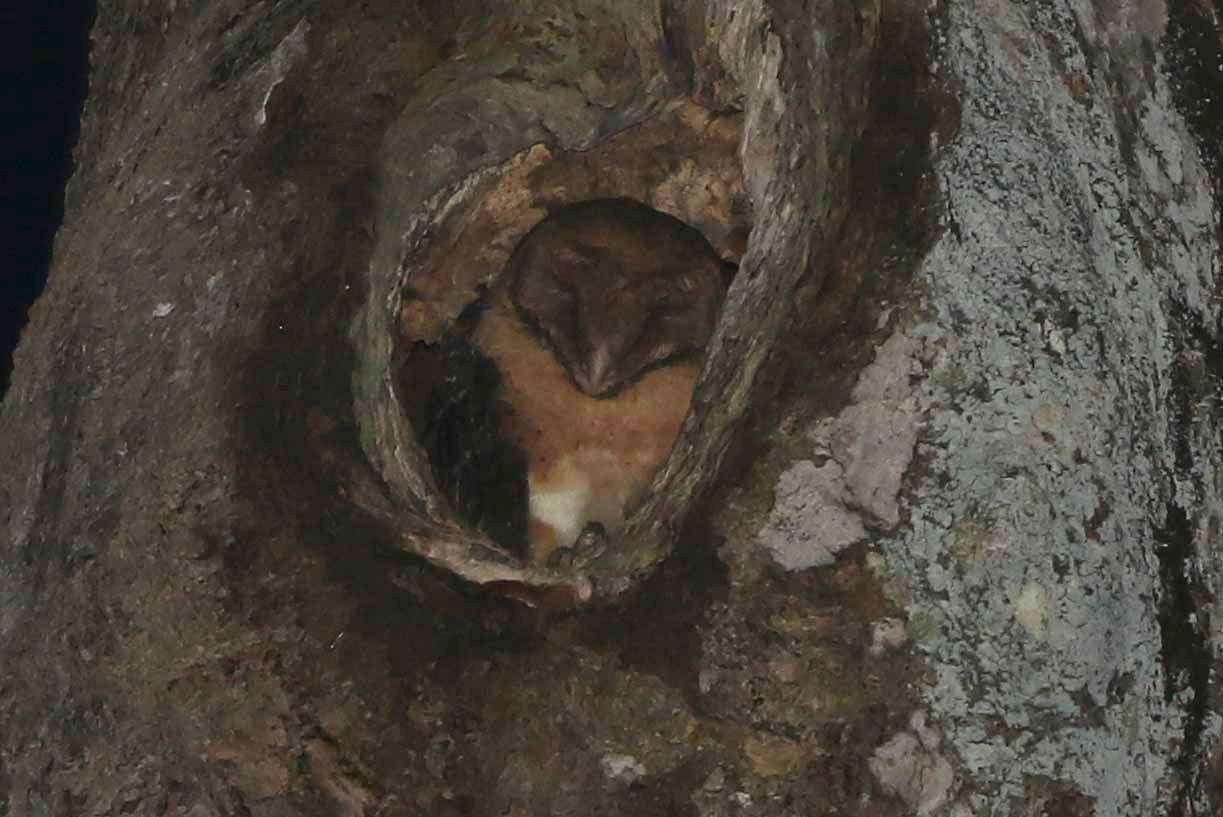
Seram Masked Owl (Ashley Banwell).

